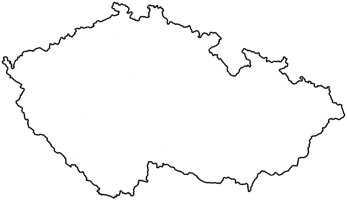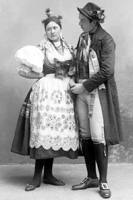
|
The Society of Folk Dance Historians (SFDH)
Czechia (Czech Republic)
[
Home |
About |
Encyclopedia | CLICK AN IMAGE TO ENLARGE |

|
 Gentle music seems to fill the air as one passes through the lovely Czech countryside. There is a unique quality in the folklore of this landlocked country, situated at the very center of continental Europe in the wide Bohemian Basin, the crossroads of migrations and conquests for over a thousand years. And that quality, or character, deserves a close examination to reveal the character of its charming people.
Gentle music seems to fill the air as one passes through the lovely Czech countryside. There is a unique quality in the folklore of this landlocked country, situated at the very center of continental Europe in the wide Bohemian Basin, the crossroads of migrations and conquests for over a thousand years. And that quality, or character, deserves a close examination to reveal the character of its charming people.
The country's recent history is well known. Emerging from the Austro-Hungarian Empire after World War I, its close ties with Austria are very evident in its folklore and folk art, which are the truest indications of a people's character and identity and we shall enjoy our visit with them.
When separated from its artificially induced brotherhood with Slovakia, there was some question about what to call themselves; the term Česká Republika and Česko in Czech ("IN the Czech Republic" you would say "v České republice"), and the Czech Republic and Czechia in English, with Česky meaning Bohemia. To most of the world, it remains "Czech Republic." The political matrix now includes the Bohemian Basin and Moravia, which comprises about a quarter of the nation along its eastern border with Slovakia and has its own unique and very rich folklore.
Its own country at last, after many decades of confusing and oppressive relationships, Czechia has become an emerging bright spot in the European community. And its folklore is as rich and alive as any in Europe; Bohemia with its historical connection with Austria, evident in its folk dress, song, and dance; Moravia with Slovakia and Hungary.
 Czech men's folk dress consists of knee-length trousers of tan or brown, white "over the knee" stockings, boots, and a vest with regional embroidery designs over a long-sleeved peasant shirt. Sometimes a decorated four-inch wide leather belt is worn. Women wear a dirndl-type dress, again with regional variations and a modest number of petticoats. The women of Plzeň, for example, wear bright red tights and a bonnet with an enormous, heavily starched shoulder-width bow in the back.
Czech men's folk dress consists of knee-length trousers of tan or brown, white "over the knee" stockings, boots, and a vest with regional embroidery designs over a long-sleeved peasant shirt. Sometimes a decorated four-inch wide leather belt is worn. Women wear a dirndl-type dress, again with regional variations and a modest number of petticoats. The women of Plzeň, for example, wear bright red tights and a bonnet with an enormous, heavily starched shoulder-width bow in the back.
Of course, the Polka is the most well-known dance and is typically danced with a soft, lilting, traveling style. Choreographers have had their way with the Polka and there are scores of variations of the dance; in addition to the gliding Polka step, the Polka employs pivots, stamps, scuffs, lifts, separations, hops, slides, and spins – most folk dancers have a nodding acquaintance with the Bohemian National Polka, which introduces a sample of the Polka's rich repertoire of figures.
A comparison with the Polka of Austria and Germany might reveal something of the Czech character. While the German Polka, and music, has a strong, intense character played by brass bands and danced with high energy and intensity with very few variations, the Czech equivalent is played by clarinets and the lovely "dudy," the mellowest and perhaps most sophisticated of the many European bagpipes. The Polka is slower, softer, smoother, gentler and more playful, allowing for the rich variety of figures.
The Polka, of course, is not the only dance; indeed, in some parts of Moravia it is not even danced. Though couple dances are most common, there are examples of dances for men and women and a study of them would take a lifetime. Farm and trade tools are frequently used as props and even instruments; weapon dances feature lifts, frequently a sustained lift of several measures length requiring strength, stamina, and skill from men and women alike.
Here is a clue to the Czech character: a gentle, warm-hearted folk who beneath their evident shyness and reserve are some of the most hospitable and welcoming of any people. Relationships between men and women appear to be very congenial and equable and women play an important role in society. An interesting pairing of free artistic expression and a love of precision has created a society with exquisite artistic traditions and a history of superb manufacturing of both light and heavy industry.
Continuing our venture into the dance, we'll take a look at Bohemia first. Most unique is the famed Furiant of Plzeň, the capital of the beer-brewing region of western Bohemia. Most references refer to it as simply "a spirited Bohemian folk dance with mixed meters." How trite. Here is one of the most interesting of all European folk dances – and one of the most demanding. The music has been the inspiration for numerous classical compositions, most notably by Dvorak in his "Bartered Bride" opera. The dance is composed of a series of figures in 2/4 and 3/4 meter and it tells the ageless story of a handsome young man who chases, charms, and wins fair maiden.
The version taught by Dr. František Bonuš consisted of a series of vignettes with a chase and retreat in three 2/4 measures and two 3/4 measures, followed by an invitation and acceptance into a vigorous figure of two eight-measures of 3/4 meter – including that very difficult sustained lift – which told of the ecstasy of the realization of love.
When asked about the dance, Dr. Bonuš stopped what he was doing and clasped his hands to his chest, gazing into memory. "Ah," he exclaimed, "that was the dance of my youth. We danced it many times. And my partner, she was so beautiful." His hands dropped to his sides and his face sobered and he smiled. "But now she's an old lady." Such is the character of the Czech.
Examples of Furiant can still be seen in performances at festivals in Bohemia, though none have displayed the vigor and demanding technique of the dance of František's youth. The logo of the Folk Dance Federation of California, South is a depiction of one of the Furiant's pursuit figures, just as he taught it.
Beseda means "company" or "visitors." The famous dance by that name has several variations throughout Bohemia and Moravia. Figures were chosen (by state leaders) from the many local regions and combined to create the "national" dance, just as Jarabe Tapatío was created in Mexico. Beseda is performed in quadrille formation in eight parts, each telling a story of young people searching for a partner to their liking. The character is formal and proper, not unlike the English and French Victorian Lancers. To see Beseda danced in South Moravia is an experience of brilliant, swirling color.
A version of Beseda was a part of the international folk dance repertoire for many years when we were still using 78 rpm (revolutions per minute) records. The dance required both sides of two records and all paused while the records were turned and exchanged between figures. Sadly, the dance has fallen away with time and few recall it today.
Situated along the eastern border with Slovakia, Moravia occupies about a quarter of the total territory of the Czech Republic and to many it is the most interesting. The region is divided ethnically into northern and southern regions; the northern part, Wallachia, is hilly, heavily forested, and is historically a logging area, beautiful and unspoiled. In truth, the region has been little studied by ethnologists and we have nothing in the repertoire from them. Perhaps here is a potential field of study for someone. Performances of local folk dances show a vigorous version of some of the softer Czech Polkas and many others using axes and staffs, a common motif among mountain folk.
And now we come to south Moravia, home of the "Moravian Slovaks" and one of the most unique areas of Central Europe. This is wine growing country and one of the nation's most treasured folk life centers. Here are some of the most elaborate folk costumes of Europe with incomprehensibly ornate embroidery, cutwork, and needlepoint embellishments to be found anywhere.
Folk festivals are an overwhelming vision of gorgeous artistic creations. This area is one in which several cultures overlapped, in this case, Slovakia, Hungary and Austria, each adding their own contributors to the very rich folklore.
Men wear tight pants, often heavily embroidered with many colors and tucked into Hungarian-style boots, also frequently embroidered. Vests are frequently very short and heavily embellished with ruching (a gathered overlay of fabric strips that are pleated, fluted, or gathered together to create a ripple-like effect), embroidery, appliqué, sequins, and braid. Shirtsleeves frequently display elaborate cutwork patterns, the amount of embellishment indicating the wearer's wealth. Long, hand-painted ribbons stream from chest to ankle.
Not to be outdone, women wear enormous skirts, sometimes fairly short, with an embarrassment of petticoats, appearing to be a gathering of beautiful, brilliantly colored bells with gossamer aprons. Elaborate boots are worn, often with intricately pleated or embroidered tops. The tight bodice gives more opportunity for elaborate embellishment, accompanied by cut-worked collars and long, painted ribbons. Of course, there is always the ornate cap to top the gorgeous ensemble.
The Podluží area has the most ornate kroj (folk dress) of any and includes the towns of Lanžhot, Hodonín, Kyjov, Vlčnov, and Horňácko.
There seem to be two kinds of dance in South Moravia; an almist inconprehensible Verbuňk, danced by the young men, and gently turning couple dances. The men's Verbuňk appears to have no structure, as does the Hungarian's Verbunk; the dancers from each town seem to have their own technique and character, some circular movements, others angular, still others more "airborne" – all very athletic. The Verbuňk is seen most often in competitions at folk festivals, the moste famous in Strážnice. The dancers are judged on artistic merit, creativity, athleticism, and singing! It is a bittersweet embarrassment to see a young man, whose voice is just changing, breathlessly croaking through a folk song in the midst of his dance, being encouraged by several musicians who gather around him to help.
The couple dances are an embarrassment to a researcher, but they are loved by the Moravians. Surely 90 percent of the dance is singing; couples stand holding hands, the women appearing as dazzling, starched little dolls in their fabulous "kroj," all singing at the top of their lungs as the men raise their free hand to the sky. When the musical phrase ends, couples assume a "hip-to-hip" position mandated by the women's enormous skirts and they gently turn with any one of several simple dance steps, sometimes walking, sometimes a little hop-step-step, but never disturbing the women's brilliant ensemble. If one cannot sing, or doesn't know the language, he or she is out of the dance. We are told that even the language of the South Moravians is very musical. An American woman who taught English at a public school in the town of Hodonín described the area as "paradise" and that was before the Soviet Union's demise. We tend to agree.
South Moravia includes a number of towns famed for their own folklore; indeed the entire Czech nation takes great pride in them and goes to great lengths to support them. There is the Whitsuntide parade of Vlčnov, folk festivals at Strážnice and Luhačovice, the "skansen" (open-air museum) at Rožnov in Wallachia, and much more.
Traditional folk dance can be found throughout the Czech lands from Plzeň in the west, Praha (Prague) in the center, Českýl Krimlov in the south, and Moravia in the east. We have barely touched on the wealth of folkore and dance. The Czechs treasure their folk traditions and it is to our benefit and enrichment to share it with them.
DOCUMENTS
- Choreogeography: Czechia and Slovakia, an article.
- Czechia, a country.
- Richard Duree, an article.
- Slovakia, a country.
Used with permission of the author.
Printed in Folk Dance Scene, December 2013.
This page © 2018 by Ron Houston.
Please do not copy any part of this page without including this copyright notice.
Please do not copy small portions out of context.
Please do not copy large portions without permission from Ron Houston.